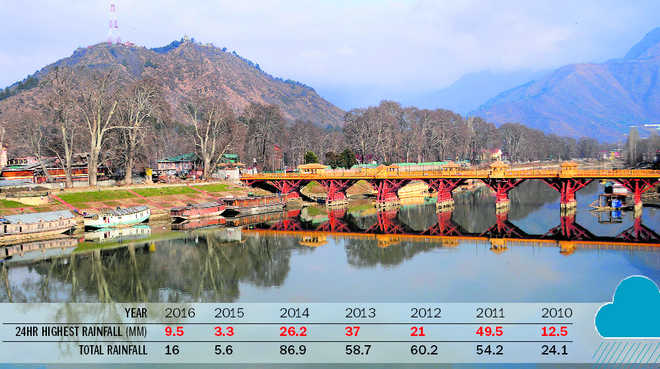
Azhar Qadri in Srinagar
It's the second week of February and Kashmir is missing the winter snow. In northern Baramulla district, where large swathes of land are neatly lined up with apple trees, Mohammad Yousuf Dar, an orchardist trader, is a worried man, hoping for rain and snow. An uncharacteristic winter, with sunny days and a prolonged dry weather, has a direct impact on production of the prized fruit, which provides earning to thousands of families.
In Pahalgam resort, located in the Lidder basin in south Kashmir, the winter sports activity including the high revenue generating heli-skiing is yet to kick off, Riyaz Ahmad, a hotelier, said."The tourists are coming but there is no rush. This place would have had three to five feet snow by now and today there is no snow at all," he said. "I have never seen such a winter."
Kashmir valley is already past the winter's 40-day harshest phase, which begins with winter solstice on December 21 -- the year's shortest day and longest night when the least amount of sunlight in received in the northern hemisphere.
Snow, one of the reasons for turning the barren winter into a picturesque season in Kashmir valley and a crucial factor in maintaining the region's ecological equilibrium, is increasingly becoming a rarity. A second consecutive January - the month of the harshest phase of cold - ended without snow in towns and villages, and the mountains that ring Srinagar city.
The lack of snowfall and a rising temperature, will hasten fruit formation. "The rising temperature will cause early flowering which should not take place else the fruit will not survive. If weather deteriorates later, it will damage the sprouted flowers. It all should take place at its own time," said Dar, the president of apple growers association in Baramulla
Apple farming and trade, based in all 10 districts of Kashmir valley, is major industry in the region and is estimated to be worth Rs 400 crore. The snowless winter and rising mercury, that Kashmir is witnessing, will damage the orchards and other horticulture industries.
It's getting hotter
Recent research studies and comparative data of the past century are pointing to a rising temperature in Kashmir, leading to scanty or no snowfall during January. Experts warn the trend may worsen over coming decades. For a second consecutive year, January recorded scanty downpour -- almost one-third of the mean precipitation recorded during this month over the last century. In January 2015, Srinagar recorded a total of 5.6 mm rainfall while the mean rainfall recorded in January between 1901 and 2000 is 62.2 mm, the data shared by the state meteorological department revealed.
This January, which recorded no major snow spell in Kashmir valley except a few bouts in higher mountainous reaches and hill resorts, Srinagar received a total of 16 mm rainfall, 46 mm less than the average rainfall recorded in the year's first month during the past century.
Irfan Rashid, assistant professor at University of Kashmir's department of Earth Sciences, said the form of winter precipitation is changing from snow to slush due to "significant rise" in minimum winter temperature. "Our findings show that winters are getting prolonged with little snowfall on account of rising temperatures. The form of winter precipitation which we used to receive predominantly as snow is changing into slush," Rashid said.
Rashid was part of a scientific team that studied the climate change impact on winter tourism in Kashmir. He said the rise in minimum temperatures during winters is impacting snow accumulation pattern, which in turn affects glacier health and stream flows.
Changing patterns
Shakil Ahmad Romshoo, the head of Earth Sciences department, warns of a resource crunch. "Snow and glaciers are the most important source that J&K has; but these are being used for hydropower, agriculture and tourism. "Our prediction is that by the end of this century, there will be 30 to 70 percent decrease in snowfall in Kashmir," Romshoo said. "It is not an abrupt phenomenon. Two-three ft snow was very common if you look at the data of Srinagar for last 100 years. A decline in the trend can easily be traced," he said.
The study by Romshoo, Rashid and two others on sustainability of winter tourism in a climate change scenario in Kashmir concluded that the actual time period for snowfall has undergone a change with December and January receiving scanty or no snowfall while February and March witnessing relatively heavy snowfall. Their study concluded that the change in snowfall pattern is "due to rise in the average temperature during winter months".
Glacial loss
The increase in temperature and the subsequent change in precipitation form will have a "serious implication" for the snow accumulation pattern with a potential to impact glacial discharge, Rashid said."The last 35 years discharge data reveals that the stream flows are showing a statistically significant decrease," he said.
A latest study, in which researchers Romshoo and Khalid Omar Murtaza studied the recent glacier changes in the Kashmir Alpine Himalayas, revealed that nine "benchmark glaciers" in the region's Lidder valley have "significantly receded. The Lidder valley is located in south-eastern Kashmir in north-west Himalayas and is spread over about 1260 sq km. The snow covers a considerable area of Lidder catchment during the winter and spring seasons, which melts and subsequently feed the springs and rivers during the rest of the year. There are about 56 glaciers in the basin, including the Kolahoi, the largest glacier in the Jhelum Basin.
"The total loss of area for the benchmark glaciers during the period is 5.20 sq.km or 17.92 percent of the total glacier area," the study said. "If the trend continues into the next few decades, it may pose a serious threat to the water availability for irrigation, hydropower generation, horticulture and recreational use," the study has warned.



























